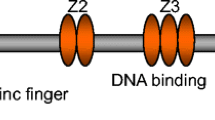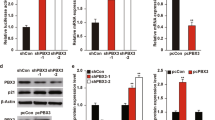Abstract
The proteins p150Sal2 (product of SALL2) and p53 share growth arrest and pro-apoptotic functions by independently inducing p21Cip1/Waf1 and BAX, and both proteins are targeted by the human papilloma virus E6 protein, leading to blockage of growth arrest in infected cells. Loss of both p53 and Sall2 in mice causes significantly higher mortality and metastasis rates compared with p53 single mutant mice. Therefore, p150Sal2 seems to have strong potential as a novel cancer biomarker for early diagnosis and risk prediction. Loss of SALL2 expression is observed in many cases of human serous ovarian carcinoma, whereas normal ovarian epithelial cells maintain high levels of the p150Sal2 protein, supporting an important tumor suppressive role for p150Sal2 in the human ovary. In contrast, p150Sal2 is a transcription factor required to convert differentiated glioblastoma cells into stem-like tumor-propagating cells, suggesting that its functional roles are dependent on tissue types and cellular context. The function of p150Sal2 in normal and diseased cells and possible therapeutic approaches are discussed in this review.


Similar content being viewed by others
References
Bandera CA, Takahashi H, Behbakht K, Liu PC, LiVolsi VA, Benjamin I, Morgan MA, King SA, Rubin SC, Boyd J (1997) Deletion mapping of two potential chromosome 14 tumor suppressor gene loci in ovarian carcinoma. Cancer Res 57:513–515
Bao S, Wu Q, McLendon RE, Hao Y, Shi Q, Hjelmeland AB, Dewhirst MW, Bigner DD, Rich JN (2006) Glioma stem cells promote radioresistance by preferential activation of the DNA damage response. Nature 444:756–760
Bohm J, Buck A, Borozdin W, Mannan AU, Matysiak-Scholze U, Adham I, Schulz-Schaeffer W, Floss T, Wurst W, Kohlhase J, Barrionuevo F (2008) Sall1, sall2, and sall4 are required for neural tube closure in mice. Am J Pathol 173:1455–1463
Chai L (2011) The role of HSAL (SALL) genes in proliferation and differentiation in normal hematopoiesis and leukemogenesis. Transfusion 51(Suppl 4):87S–93S
Chai F, Li HY, Wang W, Zhu XJ, Li Y, Wang S, Guo L, Zhang LK, Xiao G (2015) Subcellular quantitative proteomic analysis reveals host proteins involved in human cytomegalovirus infection. Biochim Biophys Acta 1854:967–978
Chen L, Willis SN, Wei A, Smith BJ, Fletcher JI, Hinds MG, Colman PM, Day CL, Adams JM, Huang DC (2005) Differential targeting of prosurvival Bcl-2 proteins by their BH3-only ligands allows complementary apoptotic function. Mol Cell 17:393–403
Cho HS, Suzuki T, Dohmae N, Hayami S, Unoki M, Yoshimatsu M, Toyokawa G, Takawa M, Chen T, Kurash JK, Field HI, Ponder BA, Nakamura Y, Hamamoto R (2011) Demethylation of RB regulator MYPT1 by histone demethylase LSD1 promotes cell cycle progression in cancer cells. Cancer Res 71:655–660
Escobar D, Hepp MI, Farkas C, Campos T, Sodir NM, Morales M, Alvarez CI, Swigart L, Evan GI, Gutierrez JL, Nishinakamura R, Castro AF, Pincheira R (2015) Sall2 is required for proapoptotic Noxa expression and genotoxic stress-induced apoptosis by doxorubicin. Cell Death Disord 6:e1816
Farkas C, Martins CP, Escobar D, Hepp MI, Castro AF, Evan G, Gutierrez JL, Warren R, Donner DB, Pincheira R (2013) Wild type p53 transcriptionally represses the SALL2 transcription factor under genotoxic stress. PLoS ONE 8:e73817
Gallagher D, Voronova A, Zander MA, Cancino GI, Bramall A, Krause MP, Abad C, Tekin M, Neilsen PM, Callen DF, Scherer SW, Keller GM, Kaplan DR, Walz K, Miller FD (2015) Ankrd11 is a chromatin regulator involved in autism that is essential for neural development. Dev Cell 32:31–42
Gonzalez GA, Montminy MR (1989) Cyclic AMP stimulates somatostatin gene transcription by phosphorylation of CREB at serine 133. Cell 59:675–680
Goujon C, Moncorge O, Bauby H, Doyle T, Ward CC, Schaller T, Hue S, Barclay WS, Schulz R, Malim MH (2013) Human MX2 is an interferon-induced post-entry inhibitor of HIV-1 infection. Nature 502:559–562
Gu H, Li D, Sung CK, Yim H, Troke P, Benjamin T (2011) DNA-binding and regulatory properties of the transcription factor and putative tumor suppressor p150 (Sal2). Biochim Biophys Acta 1809:276–283
Lamouille S, Derynck R (2009) Oncogene and tumour suppressor: the two faces of SnoN. EMBO J 28:3459–3460
Lee TC, Ziff EB (1999) Mxi1 is a repressor of the c-Myc promoter and reverses activation by USF. J Biol Chem 274:595–606
Li D, Dower K, Ma Y, Tian Y, Benjamin TL (2001) A tumor host range selection procedure identifies p150(sal2) as a target of polyoma virus large T antigen. Proc Natl Acad Sci USA 98:14619–14624
Li D, Tian Y, Ma Y, Benjamin T (2004) p150(Sal2) is a p53-independent regulator of p21(WAF1/CIP). Mol Cell Biol 24:3885–3893
Liu H, Adler AS, Segal E, Chang HY (2007) A transcriptional program mediating entry into cellular quiescence. PLoS Genet 3:e91
Liu J, Wang L, Yang A, Jiang P, Wang M (2014) Up-regulation of SALL4 associated with poor prognosis in gastric cancer. Hepato-gastroenterology 61:1459–1464
Negrini S, Prada I, D’Alessandro R, Meldolesi J (2013) REST: an oncogene or a tumor suppressor? Trends Cell Biol 23:289–295
Parroche P, Touka M, Mansour M, Bouvard V, Thepot A, Accardi R, Carreira C, Roblot GG, Sylla BS, Hasan U, Tommasino M (2011) Human papillomavirus type 16 E6 inhibits p21(WAF1) transcription independently of p53 by inactivating p150(Sal2). Virology 417:443–448
Pavlovic J, Zurcher T, Haller O, Staeheli P (1990) Resistance to influenza virus and vesicular stomatitis virus conferred by expression of human MxA protein. J Virol 64:3370–3375
Rao F, Xu J, Khan AB, Gadalla MM, Cha JY, Xu R, Tyagi R, Dang Y, Chakraborty A, Snyder SH (2014) Inositol hexakisphosphate kinase-1 mediates assembly/disassembly of the CRL4-signalosome complex to regulate DNA repair and cell death. Proc Natl Acad Sci USA 111:16005–16010
Rowland BD, Peeper DS (2006) KLF4, p21 and context-dependent opposing forces in cancer. Nat Rev Cancer 6:11–23
Sato A, Matsumoto Y, Koide U, Kataoka Y, Yoshida N, Yokota T, Asashima M, Nishinakamura R (2003) Zinc finger protein sall2 is not essential for embryonic and kidney development. Mol Cell Biol 23:62–69
Schoggins JW, Wilson SJ, Panis M, Murphy MY, Jones CT, Bieniasz P, Rice CM (2011) A diverse range of gene products are effectors of the type I interferon antiviral response. Nature 472:481–485
Siegel RL, Miller KD, Jemal A (2015) Cancer Statistics, 2015. CA Cancer J Clin 65:5–29
Sung CK, Yim H (2015) The tumor suppressor protein p150sal2 in carciongenesis. Tumor Biol 36:489–494
Sung CK, Dahl J, Yim H, Rodig S, Benjamin TL (2011) Transcriptional and post-translational regulation of the quiescence factor and putative tumor suppressor p150(Sal2). FASEB J 25:1275–1283
Sung CK, Yim H, Gu H, Li D, Andrews E, Duraisamy S, Li C, Drapkin R, Benjamin T (2012) The polyoma virus large T binding protein p150 is a transcriptional repressor of c-MYC. PLoS ONE 7:e46486
Sung CK, Li D, Andrews E, Drapkin R, Benjamin T (2013) Promoter methylation of the SALL2 tumor suppressor gene in ovarian cancers. Mol Oncol 7:419–427
Suva ML, Rheinbay E, Gillespie SM, Patel AP, Wakimoto H, Rabkin SD, Riggi N, Chi AS, Cahill DP, Nahed BV, Curry WT, Martuza RL, Rivera MN, Rossetti N, Kasif S, Beik S, Kadri S, Tirosh I, Wortman I, Shalek AK, Rozenblatt-Rosen O, Regev A, Louis DN, Bernstein BE (2014) Reconstructing and reprogramming the tumor-propagating potential of glioblastoma stem-like cells. Cell 157:580–594
Tanimura N, Saito M, Ebisuya M, Nishida E, Ishikawa F (2013) Stemness-related factor Sall4 interacts with transcription factors Oct-3/4 and Sox2 and occupies Oct-Sox elements in mouse embryonic stem cells. J Biol Chem 288:5027–5038
Wang ZG, Zheng H, Gao W, Han J, Cao JZ, Yang Y, Li S, Gao R, Liu H, Pan ZY, Fu SY, Gu FM, Xing H, Ni JS, Yan HL, Ren H, Zhou WP (2016) eIF5B increases ASAP1 expression to promote HCC proliferation and invasion. Oncotarget 7:62327–62339
Wu Z, Cheng K, Shi L, Li Z, Negi H, Gao G, Kamle S, Li D (2015) Sal-like protein 2 upregulates p16 expression through a proximal promoter element. Cancer Sci 106:253–261
Yang L, Han Y, Suarez Saiz F, Minden MD (2007) A tumor suppressor and oncogene: the WT1 story. Leukemia 21:868–876
Yang CM, Chiba T, Brill B, Delis N, von Manstein V, Vafaizadeh V, Oellerich T, Groner B (2015) Expression of the miR-302/367 cluster in glioblastoma cells suppresses tumorigenic gene expression patterns and abolishes transformation related phenotypes. Int J Cancer 137:2296–2309
Zhang J, Tam WL, Tong GQ, Wu Q, Chan HY, Soh BS, Lou Y, Yang J, Ma Y, Chai L, Ng HH, Lufkin T, Robson P, Lim B (2006) Sall4 modulates embryonic stem cell pluripotency and early embryonic development by the transcriptional regulation of Pou5f1. Nat Cell Biol 8:1114–1123
Zhang W, Gao Y, Li P, Shi Z, Guo T, Li F, Han X, Feng Y, Zheng C, Wang Z, Li F, Chen H, Zhou Z, Zhang L, Ji H (2014) VGLL4 functions as a new tumor suppressor in lung cancer by negatively regulating the YAP-TEAD transcriptional complex. Cell Res 24:331–343
Zihni C, Mitsopoulos C, Tavares IA, Ridley AJ, Morris JD (2006) Prostate-derived sterile 20-like kinase 2 (PSK2) regulates apoptotic morphology via C-Jun N-terminal kinase and Rho kinase-1. J Biol Chem 281:7317–7323
Acknowledgements
This work was supported by the National Science Foundation (to CKS; NSF CBET-1504174) and the research fund of Hanyang University (HY-2014-N) to HY.
Author information
Authors and Affiliations
Corresponding author
Ethics declarations
Conflict of interest
The authors declare no conflict of interest.
Rights and permissions
About this article
Cite this article
Sung, C.K., Yim, H. Roles of SALL2 in tumorigenesis. Arch. Pharm. Res. 40, 146–151 (2017). https://doi.org/10.1007/s12272-016-0874-x
Received:
Accepted:
Published:
Issue Date:
DOI: https://doi.org/10.1007/s12272-016-0874-x




